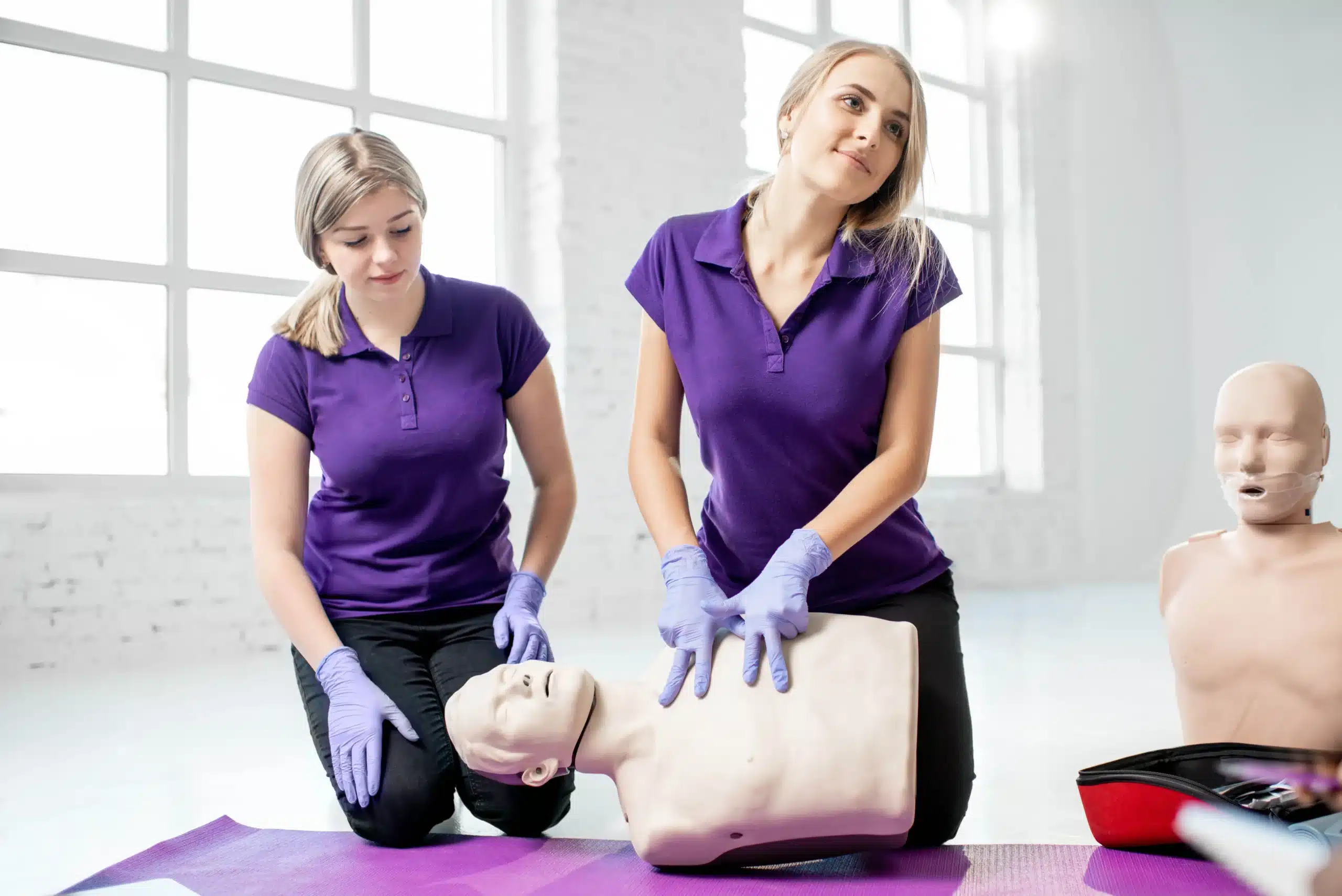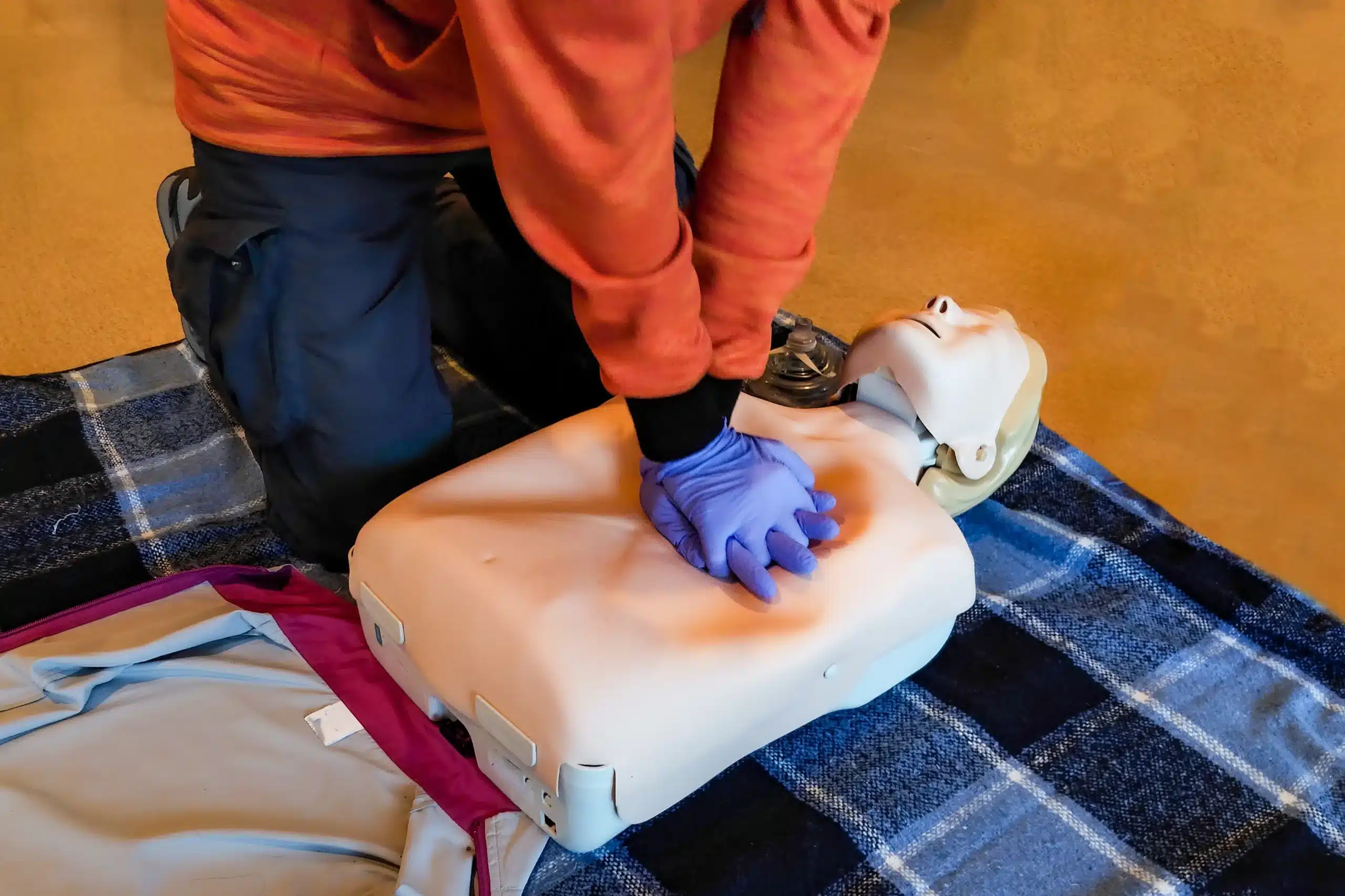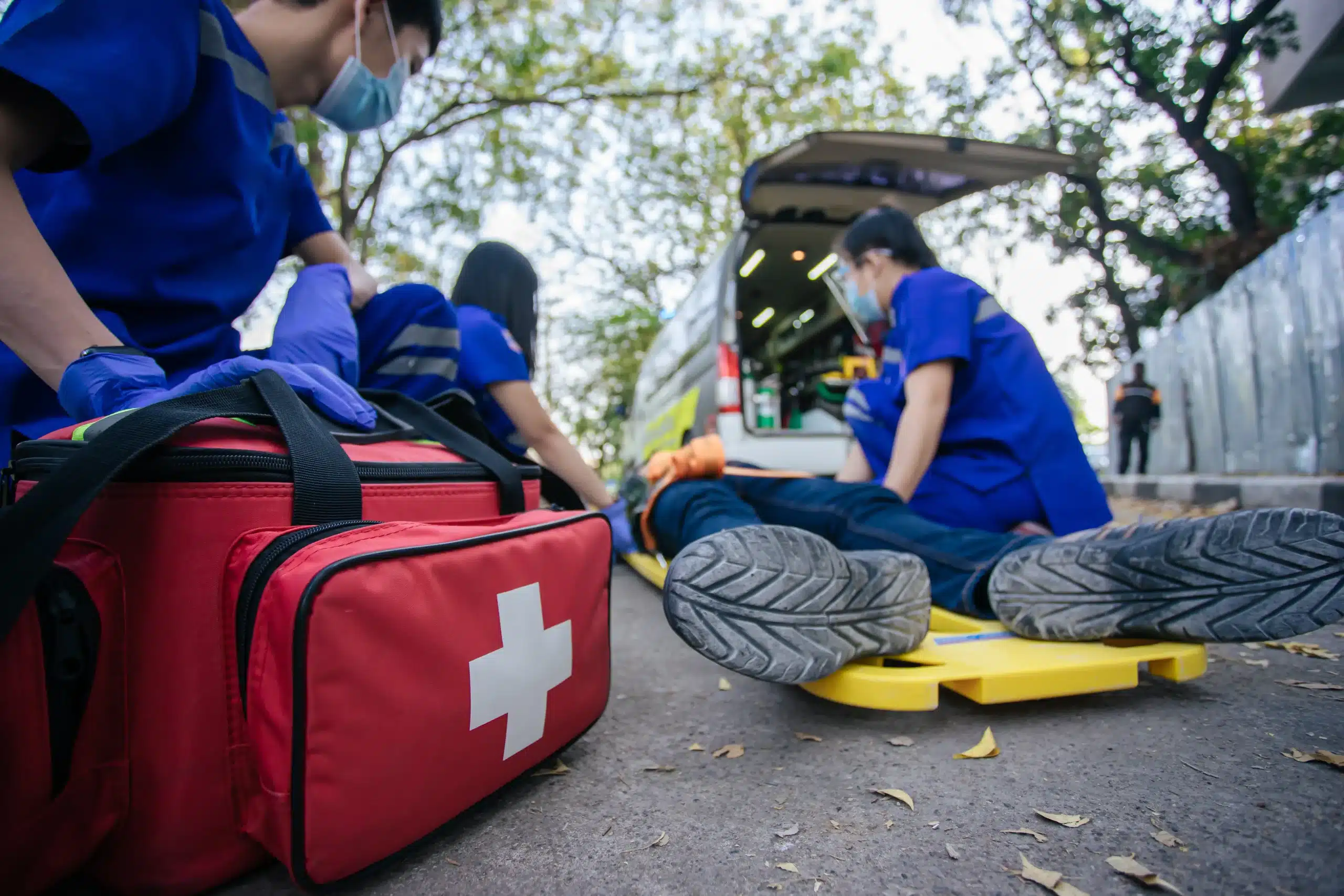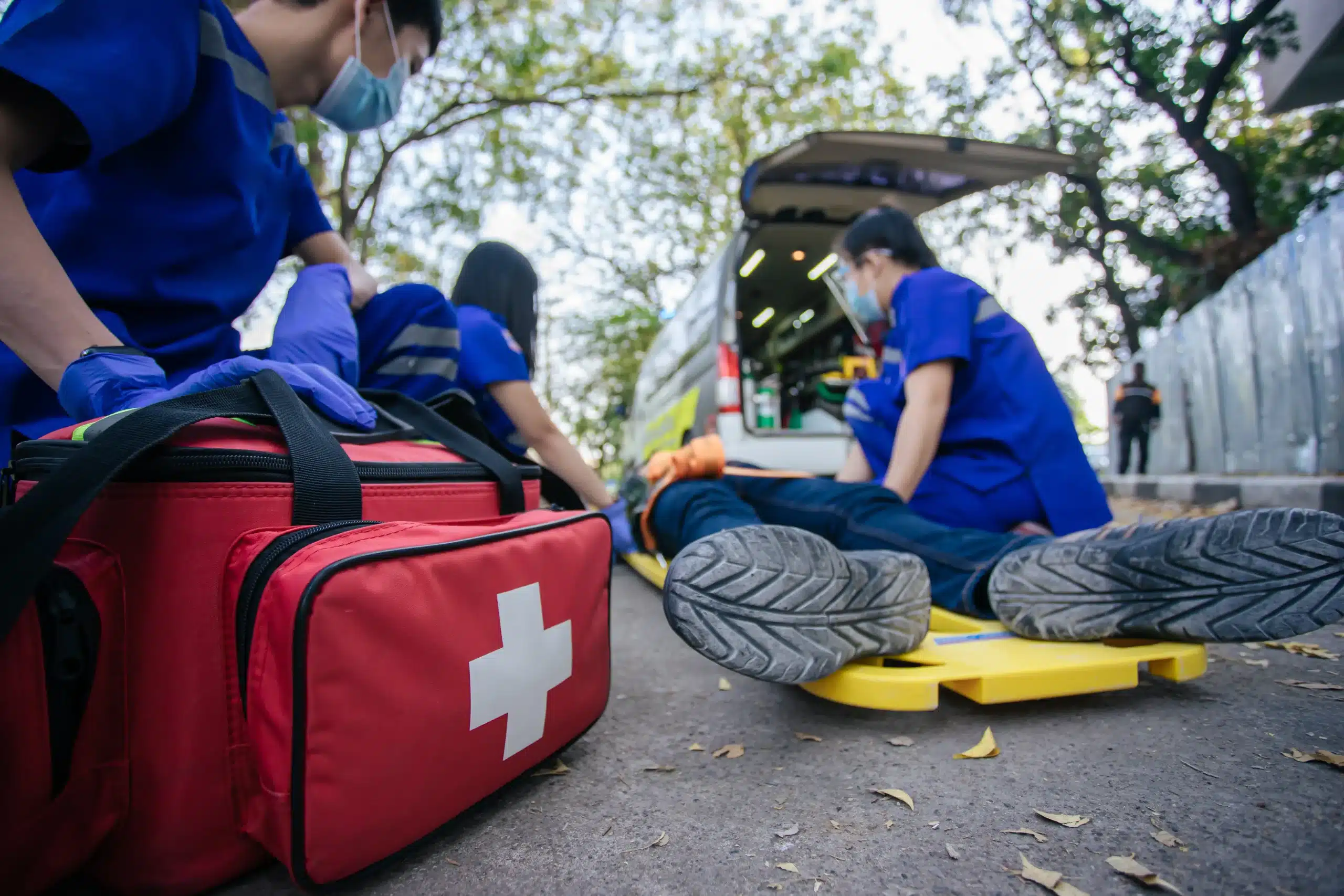Medical emergencies can happen anytime, anywhere. Would you know what to do if someone near you experienced cardiac arrest, stopped breathing, or started choking? Basic Life Support (BLS) training empowers you to respond effectively in these critical situations. This comprehensive guide covers everything from the importance of BLS certification to finding the right training program, including options for basic life support nearby. Whether you’re a healthcare provider, a concerned parent, or simply someone who wants to be prepared, this article will help you understand the value of BLS and guide you toward becoming a confident first responder.
Key Takeaways
- BLS skills save lives: Learning BLS, whether you’re a healthcare provider or not, equips you to handle medical emergencies and significantly improves survival rates. Find a course format—online, in-person, or blended—that works for you.
- Select a reputable training provider: Choose a provider accredited by a trusted organization like the American Heart Association or American Red Cross. Consider instructor experience, student feedback, and cost when making your decision.
- Stay up-to-date: Maintain your BLS skills and knowledge by renewing your certification every two years and pursuing continuing education opportunities. This ensures you’re always prepared to respond effectively.
What is BLS? Why is it Important?
Basic Life Support (BLS) is a crucial set of lifesaving skills for anyone facing a medical emergency. It provides the immediate care someone needs when experiencing cardiac arrest, respiratory distress, or choking. BLS covers essential techniques like CPR (cardiopulmonary resuscitation), using an AED (automated external defibrillator), and clearing obstructed airways in adults, children, and infants. This training is especially important for healthcare providers—think nurses, doctors, and EMTs—because they’re often the first responders in these critical situations. But it’s a valuable skillset for anyone who wants to be prepared to help in an emergency.
Think of BLS as the first link in a chain of survival. High-quality BLS delivered quickly and correctly dramatically increases the chances of someone surviving cardiac arrest. Studies show that prompt intervention can double or even triple a person’s odds of survival. Beyond the immediate medical response, BLS training creates a culture of preparedness. When more people know these skills, they become confident responders, ready to step in and provide assistance until professional medical help arrives. BLS certification empowers individuals to make a real difference in life-or-death situations.
Find Top BLS Training Near You
Finding the right BLS training program is crucial, whether you’re a healthcare professional or want to learn life-saving skills. Here are some places to explore when searching for BLS certification or recertification courses:
Santa Clara CPR Classes
Santa Clara CPR Classes offers various American Heart Association certification courses, including BLS. They focus on convenient schedules, easy registration, and daily availability in Santa Clara and surrounding cities like Milpitas and San Jose. Their commitment to customer service and a low price guarantee makes them a solid option.
American Heart Association
The American Heart Association (AHA) is a leading authority on CPR and BLS training. They offer various courses, including online options, which are often preferred by busy healthcare providers. Many courses include training manuals and online resources to support your learning. Use their website to find a BLS class near you.
American Red Cross
The American Red Cross also provides BLS training, particularly for healthcare professionals like nurses, physicians, and EMS personnel. Their BLS course equips participants with the skills to respond to breathing and cardiac emergencies in adults, children, and infants. You can locate Red Cross training centers and available courses on their website.
Local Hospitals and Medical Centers
Many local hospitals and medical centers offer BLS certification and recertification courses. This can be a convenient and affordable option, especially for healthcare professionals working in those facilities. Check with hospitals in your area for course schedules and pricing. They sometimes offer discounts for employees or community members.
Community Colleges
Community colleges frequently offer BLS training as part of their continuing education programs. These courses are often a cost-effective way to gain or renew your BLS certification. Contact your local community college to inquire about BLS training availability.
Compare BLS Training Formats
Choosing the right BLS training format depends on your learning style, schedule, and preferences. Let’s break down the pros and cons of each option so you can find the best fit.
In-Person Classes: Hands-On Learning
In-person BLS classes offer a structured learning environment with direct interaction with a certified instructor. This format shines when it comes to hands-on training. Practicing skills like CPR and using an AED on mannequins in real time builds confidence and competence. The American Red Cross emphasizes this hands-on component as crucial for responding effectively in emergencies. In-person classes also provide immediate feedback and allow you to ask questions and clarify doubts on the spot. If you thrive in a traditional classroom setting and value face-to-face instruction, in-person training might be your best bet.
Online Courses: Flexibility and Convenience
If your schedule is packed or you prefer learning at your own pace, an online BLS course offers maximum flexibility. You can complete the theoretical coursework whenever and wherever it’s convenient. Many online courses use interactive modules and adapt to your learning speed, potentially reducing the overall time commitment. This format is perfect for those who are comfortable with online learning and want to fit BLS training into a busy lifestyle. Keep in mind that online courses typically require an in-person skills session to complete your certification.
Blended Learning: The Best of Both Worlds
Blended learning combines the best of both worlds. You’ll complete the cognitive portion of the course online, enjoying the flexibility and self-pacing of online learning. Then, you’ll attend an in-person skills session to practice and demonstrate your proficiency. This format caters to various learning styles and offers a balanced approach. The blended learning format allows you to absorb information at your own speed online and then get personalized feedback and hands-on practice with a certified instructor.
What to Expect in a BLS Course
So, you’re ready to take a BLS course? Great! Knowing what to expect can help you feel prepared and confident. This section covers the typical duration, key skills taught, and how the certification process works.
Course Duration and Time Commitment
BLS courses are designed to be comprehensive but efficient. You can expect a BLS course, including recertification, to last anywhere from a few hours to a full day, depending on the format (in-person, blended, or online) and whether you’re pursuing initial certification or recertification. Recertification courses are generally shorter. Factor in extra time for any pre-course work if required, as well as breaks during the course itself.
Essential Skills You’ll Learn
BLS courses equip you with fundamental life-saving skills applicable to various emergencies. The curriculum typically includes high-quality CPR for adults, children, and infants, proper use of an automated external defibrillator (AED), and techniques for relieving choking. You’ll also learn about the importance of teamwork and communication in emergency situations. Many courses, like those offered by the American Heart Association, emphasize early recognition and response to cardiac arrest and other life-threatening conditions. You’ll practice these skills through hands-on training with mannequins and other equipment, often in simulated scenarios.
How Certification Works
BLS certification typically involves successfully completing a course accredited by a recognized organization like the American Heart Association or the American Red Cross. This includes demonstrating proficiency in the practical skills and passing a written exam. Upon successful completion, you’ll receive a certification card, typically valid for two years. To maintain your credentials, you’ll need to complete a recertification course before your current certification expires. Maintaining your certification demonstrates your ongoing commitment to providing high-quality care and staying current with the latest guidelines.
BLS Training Costs & Value
Getting your BLS certification or recertification is an investment in your skills and ability to respond to emergencies. Understanding the costs associated with BLS training and recognizing its value helps you make informed decisions. Let’s break down the typical price ranges, potential discounts, and how to find the best value.
Typical Prices for Different Formats
BLS certification and recertification costs vary based on several factors, including the training format (online, in-person, or blended learning), your location, and the training provider. Generally, BLS recertification courses range from $50 to $80. Initial certification courses might be slightly higher. In-person training often involves costs associated with classroom facilities, equipment, and instructor time, influencing the overall price. Online BLS courses sometimes offer more budget-friendly options, as they eliminate some of these overhead costs.
Discounts and Group Rates
Many training centers offer discounts and promotions, so it’s worth asking about deals. Some providers offer discounts for groups, making it a cost-effective option for workplaces looking to certify or recertify their staff. Bundling courses, such as combining BLS with ACLS or PALS recertification, can also lead to savings. Check with your chosen provider, like Santa Clara CPR Classes, about available discounts. We’re committed to providing affordable, high-quality training and offer a Low Price Guarantee.
Low Price Guarantees
A low price guarantee ensures you’re getting the best possible value. It means the training center will match or beat a competitor’s price, giving you confidence that you’re not overpaying. This is a great way to save money, especially when comparing multiple providers. Contact us to learn more about our Low Price Guarantee and access top-notch BLS training at a competitive price.
Evaluate BLS Training Provider Quality
Finding the right BLS training provider involves more than just picking a convenient location. It’s about ensuring you receive high-quality instruction that meets nationally recognized standards. Here’s what to consider when evaluating a potential provider:
Accreditation and Affiliations
Look for providers accredited by reputable organizations like the American Heart Association (AHA) or the American Red Cross. These organizations maintain rigorous standards for BLS training, ensuring the curriculum is up-to-date and evidence-based. The AHA, for example, emphasizes that adhering to their guidelines during BLS training leads to improved patient outcomes. Accreditation also signals a commitment to quality and ongoing instructor development. Check if the provider is affiliated with local hospitals or medical centers, which can further indicate a strong connection to the healthcare community.
Instructor Qualifications
Experienced, certified instructors are key to effective BLS training. Instructors should hold current certifications in BLS for Healthcare Providers (or an equivalent) and participate in regular refresher courses to stay updated on the latest guidelines and techniques. The American Red Cross, for instance, requires their instructors to maintain current certifications and complete online refresher training. Don’t hesitate to ask about an instructor’s background, experience, and teaching style. A comfortable learning environment with a knowledgeable instructor can significantly impact your learning experience.
Student Feedback
Previous students can offer valuable insights into a training provider’s strengths and weaknesses. Look for reviews and testimonials on the provider’s website or social media pages. Pay attention to comments about the quality of instruction, course materials, and overall learning experience. While the cost of BLS certification varies, prioritize finding a provider that delivers value through comprehensive training and a supportive learning environment. CPR Care offers some helpful insights into the factors affecting BLS certification costs. A provider with consistently positive student feedback is more likely to offer a high-quality learning experience.
Choose the Right BLS Course
Picking the right BLS course depends on a few factors, like your current certification status, career goals, and preferred learning style. Let’s break down the different types of BLS courses so you can find the perfect fit.
Healthcare Provider vs. Layperson Courses
BLS courses are designed for different audiences. Healthcare providers, such as doctors, nurses, and EMTs, need a more comprehensive BLS certification than someone seeking general knowledge. Healthcare provider courses from organizations like the American Heart Association and the American Red Cross cover advanced skills like using a bag-valve mask and managing airways. Layperson courses, while still valuable, focus on the fundamentals of CPR and AED use. If you’re a healthcare professional, make sure you choose a course designed for your needs. The American Red Cross offers a BLS course specifically for healthcare providers.
Initial Certification vs. Renewal
If you’re brand new to BLS, you’ll need an initial certification course. These courses cover the core BLS skills and provide you with your first certification card. Renewal courses are shorter refresher courses for people whose certifications are about to expire. Check the expiration date on your current card and sign up for a renewal course before it lapses. This will keep your skills sharp and ensure you’re always ready to respond to an emergency.
Specialized BLS Training
Beyond the standard BLS certification, there are specialized courses tailored to specific industries or situations. For example, if you work in a hospital, you might consider a course that covers advanced cardiac life support (ACLS). Pediatric advanced life support (PALS) is another specialized certification for healthcare providers who work with children. Some organizations also offer BLS courses specifically for dental professionals or those working in wilderness settings. Consider your work environment and whether specialized training might be beneficial. For example, Santa Clara CPR Classes offers RQI classes for healthcare professionals. Think about your specific needs and explore the different options available.
Prepare for Your BLS Training
Getting ready for your BLS training involves a little prep work—mentally and physically—and gathering your materials. Here’s how to get organized:
Required Materials
For in-person BLS training, you’ll likely need a BLS provider manual. Some classes include this in the registration fee, while others may require you to purchase it separately. Check with your chosen training center—Santa Clara CPR Classes, for example, can answer any questions you may have. Many recertification courses also offer online resources like videos and practice tests to reinforce your learning. Having these materials ready beforehand lets you get the most out of your training.
Pre-Course Study Resources
Take advantage of any pre-course materials offered. Reviewing the BLS provider handbook and familiarizing yourself with basic life support concepts and techniques before class can be incredibly helpful. Many courses include practice multiple-choice questions that can give you a sense of what to expect on the certification exam. This preparation can make the entire learning process smoother and more efficient.
Physical and Mental Preparation
BLS training involves hands-on practice of skills like CPR and using an AED. Wear comfortable clothing that allows for a full range of motion. It’s also important to be mentally prepared. High-quality BLS is a critical link in the chain of survival, and your training will equip you with the skills to potentially save a life. Understanding the importance of CPR can help you approach the training with focus and commitment. A good night’s sleep before your training can also help ensure you’re alert and ready to learn.
Maintain Your BLS Certification
Once you’ve earned your BLS certification, staying current is key. Knowing how to maintain your BLS skills ensures you’re always prepared to provide effective, life-saving care. This section covers everything you need to know about BLS renewal requirements, continuing education, and staying up-to-date with the latest guidelines.
Renewal Requirements
BLS certification, like CPR certification, typically expires every two years. You’ll need to complete a recertification course to maintain your credentials and stay current with the latest techniques. Recertification involves demonstrating your skills and knowledge through written and practical exams. Check with your certifying organization, such as the American Heart Association or the American Red Cross, for specific renewal requirements. Renewal courses are often shorter and more focused on refreshing essential skills than initial certification courses. Expect recertification to cost somewhere between $50 and $80, though prices can vary based on location and provider. Some providers offer a low price guarantee for their courses.
Continuing Education
Beyond formal recertification, continuing education is crucial for healthcare providers. Staying informed about the latest advancements in BLS techniques and best practices can significantly impact patient outcomes. The American Heart Association emphasizes the importance of high-quality BLS training and its connection to improved patient survival rates. Seek out opportunities to expand your knowledge through workshops, conferences, online resources, and peer-to-peer learning.
Stay Updated with Guidelines
Emergency cardiovascular care guidelines are periodically updated to reflect the latest scientific evidence and best practices. Staying informed about these changes is essential for providing the most effective care. Organizations like the American Heart Association and the American Red Cross regularly publish updated guidelines for BLS. Make it a habit to review these updates and incorporate them into your practice. The American Red Cross BLS course is designed to equip healthcare professionals with the skills to respond to breathing and cardiac emergencies in adults, children, and infants, aligning with current guidelines. By staying current with evolving standards, you can ensure your BLS skills remain sharp and relevant.
How Quality BLS Training Impacts Healthcare and Community Safety
Quality Basic Life Support (BLS) training is critical for better healthcare outcomes and overall community safety. Think of it as a vital link in the chain of survival. When someone delivers high-quality BLS right away, based on the latest evidence-based guidelines, it’s linked to much better patient outcomes. This highlights how important it is for healthcare providers to have solid training in these life-saving techniques. Fast action can dramatically increase the chances of survival during cardiac emergencies.
The American Heart Association explains that BLS training focuses on core life-saving skills. These include CPR, using an AED, and helping someone who is choking. It’s essential training for a wide range of healthcare professionals. This training not only gives these professionals the skills they need to respond effectively in emergencies, but it also creates a culture of preparedness that benefits entire communities. For those in Santa Clara, San Jose, and Milpitas, Santa Clara CPR Classes offers convenient options for this vital training.
The American Red Cross also points out that their BLS course is designed for a variety of healthcare professionals. This includes nurses, doctors, EMS personnel, certified nursing assistants, and other healthcare and public safety workers. They learn how to respond to breathing and cardiac emergencies in adults, children, and infants. This comprehensive training makes sure a diverse group of people is ready to act quickly and efficiently in critical situations, making our communities safer. If you’re looking for training options, explore the courses available through Santa Clara CPR Classes.
Quality BLS training isn’t just a box to check off for healthcare providers; it’s a vital part of a healthy and safe community. Investing in BLS education empowers people to save lives and makes our world a safer place.
Related Articles
- BLS Training Near Me: A Practical Guide – Santa Clara CPR Classes
- BLS Certification in San Jose: Your Complete Guide – Santa Clara CPR Classes
- BLS Certification Near Me: Your Complete Guide – Santa Clara CPR Classes
- BLS Classes in Santa Clara: The Complete Guide – Santa Clara CPR Classes
Frequently Asked Questions
What’s the difference between BLS and CPR? CPR, or cardiopulmonary resuscitation, is one of the core techniques taught within a BLS course. BLS encompasses a broader range of skills, including CPR, using an AED, and relieving choking. Think of CPR as a component of the larger BLS skillset.
How often do I need to renew my BLS certification? BLS certification is typically valid for two years. To maintain your credentials, you’ll need to complete a recertification course before your current certification expires.
What if I have a busy schedule? Can I still get BLS certified? Absolutely! Online and blended learning options offer flexibility for those with busy schedules. You can complete the coursework online at your own pace and then schedule an in-person skills session when it’s convenient.
How do I choose a reputable BLS training provider? Look for providers accredited by recognized organizations like the American Heart Association or the American Red Cross. Check instructor qualifications, read student reviews, and compare pricing to find the best fit.
Why is BLS important for everyone, not just healthcare professionals? While crucial for healthcare providers, BLS skills are valuable for anyone. Knowing how to respond to emergencies like cardiac arrest or choking can make a real difference before professional help arrives. It empowers individuals to potentially save lives in their communities.





